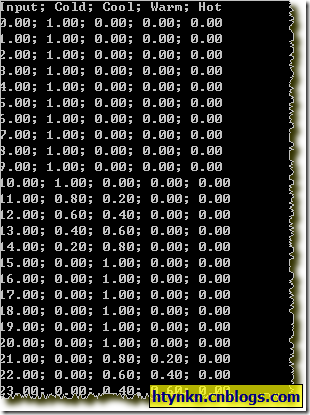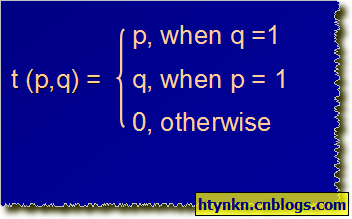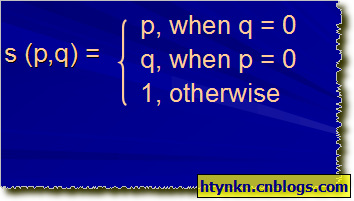模糊语意变数、规则和模糊运算--AForge.NET框架的使用(二)
语意变数(Linguistic Variable)
语意变数存储了数个语意量(标签),每个语意量包含一个识别名和模糊集合。在宣告陈述时每个语意量只能和在同一变数中的语意比较。
举个很简单的例子,我们有一个名为temperature的语意变数,它包含4个语意量,名为cold、cool、warm、hot,这也是各自的标签名,同时它们还有各自的隶属度函数。
那么我们就在接下来的系统中使用诸如temperature is hot或者temperature is not hot等等了。
//语意变数的声明
LinguisticVariable lvTemperature = new LinguisticVariable("Temperature", 0, 50);
//模糊集合和隶属度函数
TrapezoidalFunction function1 = new TrapezoidalFunction(10, 15, TrapezoidalFunction.EdgeType.Right);
FuzzySet fsCold = new FuzzySet("Cold", function1);
TrapezoidalFunction function2 = new TrapezoidalFunction(10, 15, 20, 25);
FuzzySet fsCool = new FuzzySet("Cool", function2);
TrapezoidalFunction function3 = new TrapezoidalFunction(20, 25, 30, 35);
FuzzySet fsWarm = new FuzzySet("Warm", function3);
TrapezoidalFunction function4 = new TrapezoidalFunction(30, 35, TrapezoidalFunction.EdgeType.Left);
FuzzySet fsHot = new FuzzySet("Hot", function4);
//添加标签
lvTemperature.AddLabel(fsCold);
lvTemperature.AddLabel(fsCool);
lvTemperature.AddLabel(fsWarm);
lvTemperature.AddLabel(fsHot);
//获取隶属度
Console.WriteLine("Input; Cold; Cool; Warm; Hot");
for (float x = 0; x < 50; x += 1f)
{
float y1 = lvTemperature.GetLabelMembership("Cold", x);
float y2 = lvTemperature.GetLabelMembership("Cool", x);
float y3 = lvTemperature.GetLabelMembership("Warm", x);
float y4 = lvTemperature.GetLabelMembership("Hot", x);
Console.WriteLine(String.Format("{0:N}; {1:N}; {2:N}; {3:N}; {4:N}",x, y1, y2, y3, y4));
}
模糊规则(Fuzzy Rule)与数据库(Fuzzy Database)
在拥有语意变数后,我们就创建表述(Statement),它是一种表达,可以做成判断,比如什么是什么,什么不是什么。
而规则(Rule)是可以被模糊系统执行的语意指令。如什么是什么时,就怎么。最简单的就是这种:
IF antecedent THEN consequent
前提(antecedent )一般由多个由模糊运算符连接的子句组成。如:
...Clause1 AND (Clause2 OR Clause3) AND NOT Clause4 ...
结果(consequent)一般由赋值子句组成,这里的赋值不光是Variable1 IS Value1,Variable1 IS Not Value1同样支持。
举个例子,再创建一个语意变数,Wind,标签有Strong、Breeze、Airless。
那么一下规则就是有效的:
IF Wind IS Strong THEN Temperature IS Cold
IF Wind IS AirlessTHEN Temperature IS NOT Cold
数据库(Fuzzy Database)是一个包含语意变数和相应规则的资料集合,它可以被模糊推理系统(Fuzzy Inference System)使用。
//语意变数的声明
LinguisticVariable lvTemperature = new LinguisticVariable("Temperature", 0, 50);
//模糊集合和隶属度函数
TrapezoidalFunction function1 = new TrapezoidalFunction(10, 15, TrapezoidalFunction.EdgeType.Right);
FuzzySet fsCold = new FuzzySet("Cold", function1);
TrapezoidalFunction function2 = new TrapezoidalFunction(10, 15, 20, 25);
FuzzySet fsCool = new FuzzySet("Cool", function2);
TrapezoidalFunction function3 = new TrapezoidalFunction(20, 25, 30, 35);
FuzzySet fsWarm = new FuzzySet("Warm", function3);
TrapezoidalFunction function4 = new TrapezoidalFunction(30, 35, TrapezoidalFunction.EdgeType.Left);
FuzzySet fsHot = new FuzzySet("Hot", function4);
//添加标签
lvTemperature.AddLabel(fsCold);
lvTemperature.AddLabel(fsCool);
lvTemperature.AddLabel(fsWarm);
lvTemperature.AddLabel(fsHot);
//语意变数的声明
LinguisticVariable lvWind = new LinguisticVariable("Wind", 0, 50);
//模糊集合和隶属度函数
TrapezoidalFunction functionw1 = new TrapezoidalFunction(25, 40, TrapezoidalFunction.EdgeType.Right);
FuzzySet fsStrong = new FuzzySet("Strong", function1);
TrapezoidalFunction functionw2 = new TrapezoidalFunction(10, 15, 25, 30);
FuzzySet fsBreeze = new FuzzySet("Breeze", function2);
TrapezoidalFunction functionw3 = new TrapezoidalFunction(5,10,TrapezoidalFunction.EdgeType.Left);
FuzzySet fsAirless = new FuzzySet("Airless", function3);
//添加标签
lvWind.AddLabel(fsStrong);
lvWind.AddLabel(fsBreeze);
lvWind.AddLabel(fsAirless);
//创建数据库
Database db = new Database();
db.AddVariable(lvTemperature);
db.AddVariable(lvWind);
//书写规则
Rule r1 = new Rule(db, "Thinking1", "IF Wind IS Strong THEN Temperature IS Cold");
Rule r2 = new Rule(db, "Thinking2", "IF Wind IS AirlessTHEN Temperature IS NOT Cold");
模糊运算
以下全是数学相关物…不喜者勿入。
模糊运算主要针对模糊集合,有3种:联集(union)、补集(complement)与交集(intersection),而依照不同定义有不同的型态。
1.交集中:
标准交集(standard intersection):t (p,q) = min (p,q)
代数乘积(algebraic product):t (p,q) = pq
有界差异(bounded different):t (p,q) = max (0, p+q-1)
彻底交集(drastic intersection):
2.联集中:
标准联集(standard intersection):s (p,q) = max (p,q)
代数加法(algebraic product): s (p,q) = p + q -pq
有界加法(bounded different): s (p,q) = min (1, p+q)
彻底联集(drastic intersection):
本来还想写模糊合成的…但是没找到可以画矩阵的软件,matlab画出来太丑了。
写在最后:
1.本文参考了很多文档和资料,特别是相关英文的对应翻译上,主要参考http://www.academia.edu相关讨论和台湾一些院校的研究报告。
2.有个不错的PPT,可以看一下:http://www.ctdisk.com/file/4479740
作者:黄云坤
出处:http://www.huangyunkun.com/
本文版权归作者所有,欢迎转载,但未经作者同意必须保留此段声明,且在文章页面明显位置给出原文连接,否则保留追究法律责任的权利。
支持:
新浪微博






 浙公网安备 33010602011771号
浙公网安备 33010602011771号